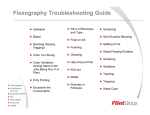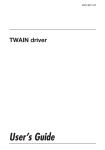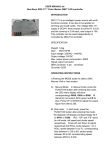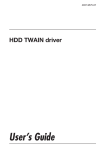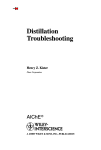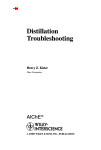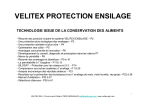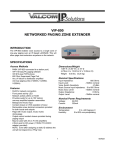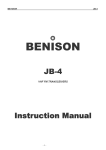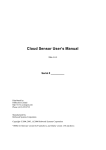Download PRESSROOM TROUBLESHOOTING CHART
Transcript
PRESSROOM TROUBLESHOOTING CHART -----------------------------------------------------------------------------------------------------------------------------------------------------------------Defects How Recognised Probable Cause Suggested Remedy --------------------------------------------------------------------------------------------------------------------------------Adhesion, poor ink Ink fails to adhere to material. 1. Improper ink formula 1. Make certain you have the correct ink for the kind and grade of stock being run. Fails tape test. 2. Ink thinned too much, destroyed. 2. Restore and hold ink viscosity at optimum point. Add fresh ink or resin binder Fails crinkle test 3. Insufficient heat; too low web temperature. 3. Increase heat and/or air volume. Fails scuff test. 4. Lack of treatment of some materials 4. Check surface of the adequate treatment. 5. Surface of stock may be contaminated. Bleed Blocking 5. Check with supplier; check advisability and effectiveness of applying washcoat before printing. An undercolor wetting into an overcolor. 1. Undercolor drying too slowly or overcolor drying too fast. 1. Use faster or slower (preceding colors must be dry enough to receive subsequent colors laid down.) Diffused or migrating colors 2. Effect of some stocks or materials on dye stuffs . 2. Avoid use of dye colorants when unknown plasticizers are likely to be involved. Undesired adhesion two web surfaces 1. Improper ink drying 2. trapped solvents. 1. Proper solvent balance. 2. effective drying system or solvent balance. 3. Excessive pressure in rewind. 3. Reduce rewind tension. 4. Softening of preapplied coatings. 4. Use solvents that do not attack prior coatings. 5. 5. Reduce web temperature by chilling within 10 0F of room temperature or reducing dryer temperature. 6. Avoid rewinding excess surface moisture into finished roll. Avoid overchilling that condenses moisture on web prior to rewind. Web rewound too warm. 6. Web rewound with excess surface moisture (2) Table 13-1 PRESSROOM TROUBLESHOOTING CHART (Continued) Defects How Recognized Probably Cause Suggested Remedy ---------------------------------------------------------------------------------------------------------------------------------------------------6. Web rewound with excess surface moisture Brittleness Stock or material that When flexed. Excess heat in drying system causing release of moisture and plasticizer from paper or film. 6. Avoid rewinding excess surface moisture into finished roll. Avoid overchilling that condenses moisture on web prior to rewind. 1. Control web or film temperature. 2. Introduce moisture into afterdryer chamber or tunnel. 3. Direct web through remoisturing chamber Chatter Parallel lines of misprint. Gear bottoming below pitch line. Drying to Fast. Ink drying on plates and/or roller and and failing to transfer to substrate. 1. Improper use of solvents 1. Proper solvent selection 2. Uncontrolled or unrestricted air movement in the in the vicinity of plates and rollers. 2. Properly balanced between-color dryers. no excessive air movement in vicinity of plates or rolls by fans or open windows, doors, etc. Drying too slow One color bleeding into another (improper trapping) ink pick-off or transfer to press rollers and /or plates. Ink offset or blocking. Adjust plate thickness to achieve pitch line. 3. Failure to use fountain covers. 3. Use fountain covers. 4. Improper ink for material. 4. Proper selection of ink for material being printed. 5. Dried ink on plates from start-up. 5. 1. Use of improper solvents. 2. Ink viscosity too heavy. 3. Inadequate or unbalanced drying system. Wash plates after color approval and before full speed run. 1. Use of proper solvents. 2. Controlled ink viscosities. Make viscosity cup every checks every 20 to 30 minutes. 3. Adequate and balanced drying system to accommodate press speeds (3) PRESSROOM TROUBLESHOOTING CHART Defects Feathering Fill-in How Recognized Probable Cause Ink penetration of paper. 4. Improper ink 4. Proper ink selection, one having more hold-out Capability. Tacky surface of 5. Lack of slip 5. Add wax to ink. Irregular string-like edges around print, often on trailing edges. 1. Improper pressure between ink transfer roll and and plate. 1. Set proper pressure between ink transfer roll and plate. 2. Ink drying on the plate or anilox. 2. Use proper solvents and fountain covers. 3. Improper setting of ink roller nip. 3. Control pressure setting of Ink roller nip. 4. Improper ink rollers. 4. Select proper ink rollers for design and material being printed. 5. Uncontrolled ink viscosity. 5. Maintain proper ink Viscosity. Check often. 6.Lint being picked up from material on plate. 6. Clean or dust material when necessary And avoid having ink too tacky. 7. Static electricity. 7. Use static eliminator bars. Piling or specking of excess ink on and around printing surface of plates – especially with relation to small type and screen dots. Suggested Remedy 1. Specks of ink pigment. 1. Use well dispersed inks. 2. Foreign matter in ink. 2. Strain ink.. 3. Excessively fine type, 3. Check design for suitability for flexo design, or anilox work , i.e., sufficient open areas, screen selection proper type face, etc. 4. Souring or precipitationion of ink vehicle solids caused by moisture absorption by the solvent in wet film. 4. See section under Souring. 5. Too much pressure. 5. Check pressure settings. 6. Rubber roller too soft. 6. Use 10 points higher durometer. 7, Excessive plate inking. 7. Select finer metering roll or improve wipe. . (4) PRESSROOM TROUBLESHOOTI NG CHART (Continued) Defects Film curl How Recognized Curl over on edges cellophane. Probable Cause Suggested Remedy 8. Ink drying too fast 8. Use slower solvent. Speed up press. 1. Curl toward coated side. 1. Excessive moisture. Introduce heat edges. Use heat guns. 2. Curl away from coated side. 2. Lack of moisture. Introduce moisture to edges. Use moist sponge. Flat process Lack of contrast 1. Poor molds and plates. 1. Prepare molds to proper floor. Printing Hazy, milky 2. Excessive plate pressure. 2. Print with kiss impression. Use compressible stickyback. 3. Viscosity too low. 3. Raise viscosity. 4. Contamination of primary colors by any other color. 4. Replace with pure transparent process colors. 1. Two in-line plates being inked from same area of the metering roll before re-inking or the meeting roll can take place. 1. Change diameter of plate cylinder or change speed differential of fountain roll to metering roll. 2. Improperly cleaned metering roll. 2. Thorough cleaning with proper brush. Ghosting Halo A faint image of a plate portion within a printed solid. A hazy colorless image of the print on in-line unprinted areas of film. 1. Moisture or solvent 1. Adequate solvent removal, drying trapped in rewound and reduced tension. roll and migrated onto the back of the wrap of film. An unwanted line surrounding a printed image. 1. Excess pressure between plate and material. 1. Reset plate pressure and ink viscosity. 2. Poor plates or makeready. 2. Perform necessary makeready. 3. Cupped edges of plate. 3. Make new plates and new plate mould, avoid cupping.. 4. Plate cylinder running out of Round. 4. Check plate cylinder, shafts and journals and gears for run-out. 5. Plate durometer too hard. 5. Use recommended rubber plates For printing given materials. Double edge printing. (5) PRESSROOM TROUBLESHOOTING CHART (Continued) Defects Ink heavy/ Strong Ink weak/thin Ink mottling How recognized Excess ink on anilox roll or plates. Lacking color strength Spotted or speckled appearance of solid print. Dark or colored intermittent streaks – usually in a light color. Probable Cause Suggested Remedy 6. Stickyback too thin and too firm. 6. Use compressible stickyback. 1. Insufficient solvent and/or high viscosity. 1. Reduce ink to proper viscosity 2. Improper setting of ink Roller nip. 2. Properly adjust roller nip. Increase or decrease nip pressure. 3. Improper ink rollers for ink transfer 3. Consult roller manufacturer for proper specification for printing on given materials and type of printing to be processed. 4. Solvent imbalance. 4. Consult your ink formulator for optimum “make-up” solvent mixture, 5. Anilox doctor blade improperly set. 5. Adjust doctor blade to shave meeting roll more clearly. 6. Improper anilox. 6. Select anilox roll with lower cell volume or ink carrying capacity. 1. Too much solvent or viscosity too low. 1. Add fresh ink and bring to proper viscosity. 2. Improper setting of ink roller nip. 2. Adjust roller nip to allow more ink on metering roll. 3. Improper ink rollers for ink transfer. 3. Consult roller manufacturer for proper specification for printing on given materials. 4. Worn anilox roll. 4. Replace with new or re -engraved roll 5. Ink settled. 5. Thoroughly mix ink from container before adding to fountain. 6. Excess extender varnish. 6. Add pigment concentrate (toner). 1. Ink too weak or too thin, and loss of tack. 1. Add fresh ink and bring to proper viscosity. Add varnish to increase tack. 2. Remake plates if mottled appearance is evident on surface. Also examine p late mold for same mottle pattern. 2. Surface of plates uneven. 3. Anilox roll cell walls too wide. 3. Check wear condition of anilox lands. Replace anilox roll. (6) PRESSROOM TROUBLESHOOTING CHART (Continued) Defects How Recognized Probable Cause Suggested Remedy 4. Foreign matter on surface of plates. 4. Wash plates thoroughly. 5. Dirty or pitted impression cylinders. 5. Clean impression cylinders thoroughly of all foreign matter, inks, waxes, etc. 6. Unevenly absorptive materials. 6. Softer plates sometimes may help; more opaque ink may help. 7. Uneven surface materials. 7. Softer plates should be tried. 8. Ink starvation from anilox. 8. Adjust with richer or slower drying solvent. 9. Contaminated Ink. 9. Clean and strain ink or replace with fresh ink. 10. Ink lacks proper flow. Misregister One part of design not correctly positioned with another. 1. Incorrect plate-up; plates not mounted in register. Undesirable dot pattern in process Printing. 1. Study plate-up, mounting and makeready procedures. 2. Incorrect web tensions. 2. Study procedures involving auxiliary equipment, P.I.V. speed variators, unwind and rewind tension controls. 3. Incorrect draw roll adjustment 3. Check draw roll parallel constant side to side pressure, centre wear condition. 4. Excessive web temperatures. 4. Reduce dryer temperatures. 5. Failure to center press register compensators before putting job in press. 5. Center forward, backward and side register compensators before manually keying in job register. 6. Idle rolls dragging or running intermittently. 6. Free all idle rolls so that they turn Freely mechanically. Drive at web speed if necessary. 7. Press out of line. 7. Check and record press alignment. 8. Moire 10. Consult ink supplier for reformulation. Gauge variations in stock. 1. Anilox screen count too similar to plate screen count. for instance, a 165 line anilox plate can cause moire – because of harmonic 85 x 2 = 170, too close to 165 line Improper screen angles. 1. Change anilox. Select a screen count appropriate for tone work Refer to chapter 14 on process printing. 2. Refer to chapter on process for Proper screen angles. (7) PRESSROOM TROUBLESHOOTING CHART (Continued) __________________________________________________________________________________________________ Defects How Recognized Probable Cause Suggested Remedy Odor Offset Or set-off Pick-off/ Ink Pinholing Undesirable odor in Printed substrate Transfer of ink to opposite side of material than that on which it was printed. First down ink transferring to Subsequent plates. Small holes in 1. Retained solvents. 1. Balance solvents and check for proper solvent. 2. Check dryer efficiency and Temperature 3. Increase between-color drying. 4. Reduce line speed. 1. Ink not dry at rewind. 1. Use faster solvents.Check between color and final dryers for obstructions and adequate air and temperature. Reduce ink viscosity to minimum acceptable; increase wipe between the fountain and anilox rolls. 2. Trapped Solvents. 2. Same as above. Reduce ink film to minimum acceptable. 3. Excess pressure in roll. 3. Reduce rewind tension. 4. Film treated on both sides for printing so that ink contacts opposite treated surface, such as 4. Avoid excess pressure in rewound rolls. Apply offset powder to web before rewinding; overprint with nonblocking varnish if necessary. 5. Films with plasticizers subject to migration, such as some vinyl film. 5. Same as remedy number 4. 1. First color too slow. 1. Add fast solvent to first color; increase between-color dryer temperature, 2. Second color too fast. 2. Add slow solvent to overprinting color. Check dryer. 3. Second-down color too high in viscosity. 3. Increase press operating speed and/or reduce viscosity of seconddown color. 1. Physical surface of some materials. 1. Consult your material supplier. 2. Failure of ink to form continuous ink-film laydown. 2. Increase ink film thickness. check impression, anilox roll to plate and plate to stock; add impression if setting is too light. Add pinhole compound to ink. If 2% or 3% fails to correct condition, call your inkmaker. PRESSROOM TROUBLESHOOTING CHART (Continued) Defects How Recognized (8) Probable Cause Suggested Remedy 3. Dirt on impression cylinder. 3. Clean impression cylinders 4. Ink drying too fast. 4. Use slower solvent or speed up press. 5. Worn anilox 5. Examine wear condition of anilox lands. replace with new or reengraved roll. Plate swelling Dimensionally larger softer than when mounted on cylinder. 1. Ink or solvents not compatible with printing plates. 1. Check ink and solvents being used with your inkmaker and plate supplier. Poor ink Transfer Insufficient ink being applied to stock 1. Ink reduced too much. 1. Rebuild tack and color strength by addition of fresh ink or extender or both. 2. Ink drying on plates. 2. See defect “Drying too fast”. Retard drying with slower drying solvent or thinner, consult inkmaker. 3. Surface of stock not receptive to ink. 3. Verify ink formulation with ink supplier for given material; check for “souring”; add “antipinhole compound;´check stock for treatment. 4. Improper pressure among ink roller, transfer roller and plate. 4. Adjust pressure. 1. Ink drying too fast on anilox roll and failing to to transfer properly to printing plate. 1. Use fountain covers. retard drying speed of of ink. Adjust exhaust on between-color dryers. 2. Worn anilox roll. 2. Exa mine wear condition of anilox lands. Replace with new or reengraved anilox. Screening A definite pattern of small holes appearing in surface of solid . Skip print Areas of plate failing to print. . 1. Poor plates or makeready. 1. Check impressions to determine accuracy of plates. Secure new plates or do necessary makeready. 2. Impressions set to light. 2. Readjust impression settings. (9) Table 13-1. PRESSROOM TROUBLESHOOTING CHART (continued) Defects How Recognized Probable Cause Suggested Remedy 3. Failure to lock down deck 3. Be sure printing sections are locked firmly in place when impression is properly set. 4. Plate cylinder “bounce”, 4. Check concentricity of plate cylinder and gears; plate cylinder shaft for flexing; journals and bearings for excessive wear. consider nature of printing plate design., Check for dried ink in gear teeth. Souring ink Thixatropic loss Of flow curdling. Excessive moisture in ink due to Humidity. Keep fountains and Reservoirs covered. Add Normal propyl acetate. Separation Or “kick out” Curdling and thixatropic (much Like souring) Presence of wrong solvent or excessive diluent. Add rich true solvent To return ink to proper balance. Streaks or Smears Blobs of lighter or darker Color in unwanted Areas on web. Streaks in web direction. Web Weave Continuous dark lines through print. Web failing to track or follow a true course through the press. 1. Gel particles are undissolved. 1. Filter particles out in circulation system and clean plates and anilox. 2. Uneven plates. 2. Check plates. 3. Foam bubbles being printed. 3. Add antifoam to ink. 4. Ink splash dripping onto web. 4. Check fountain guards, ink sling rings and pans for over flow , leaks. 1. Damaged fountain or anilox roll. 1. Sharp spot on anilox can cut fountain roll. Polish anilox and grind streak out of fountain roll. 2. Nick in doctor blade. 2. Hone or replace doctor blade. 1. Press out of alignment . 1. Check press alignment. 2. A roller out of alignment. 2. Check individual rolls for alignment. 3. Build up of ink, tape or foreign matter on press 3. Clean all rolls of foreign matter. 4. Too much heat one web, such As polyethytlene. 4. Reduce web temperature. (10) Table 13-1 PRESSROOM TROUBLESHOOTING CHART (Continued) Defects Wrinkling How Recognized Wrinkles in substrate. Probable Causes Suggested Remedy 5. Web guides not operating or set properly. 5. Check and clean web Guides regularly per manufacturer’s instructions. Set web guides and position cores so that web will unwind and rewind at an equal measurement from the end of the respective shafts. 6. “Gauge” problems with 6. Replace roll of stock with ne w roll. 1. Baggy substrate. 1. Tape rollers at web edge to draw out wrinkles. 2. Equipment misalignment. 2. Adjust all roller alignment.










